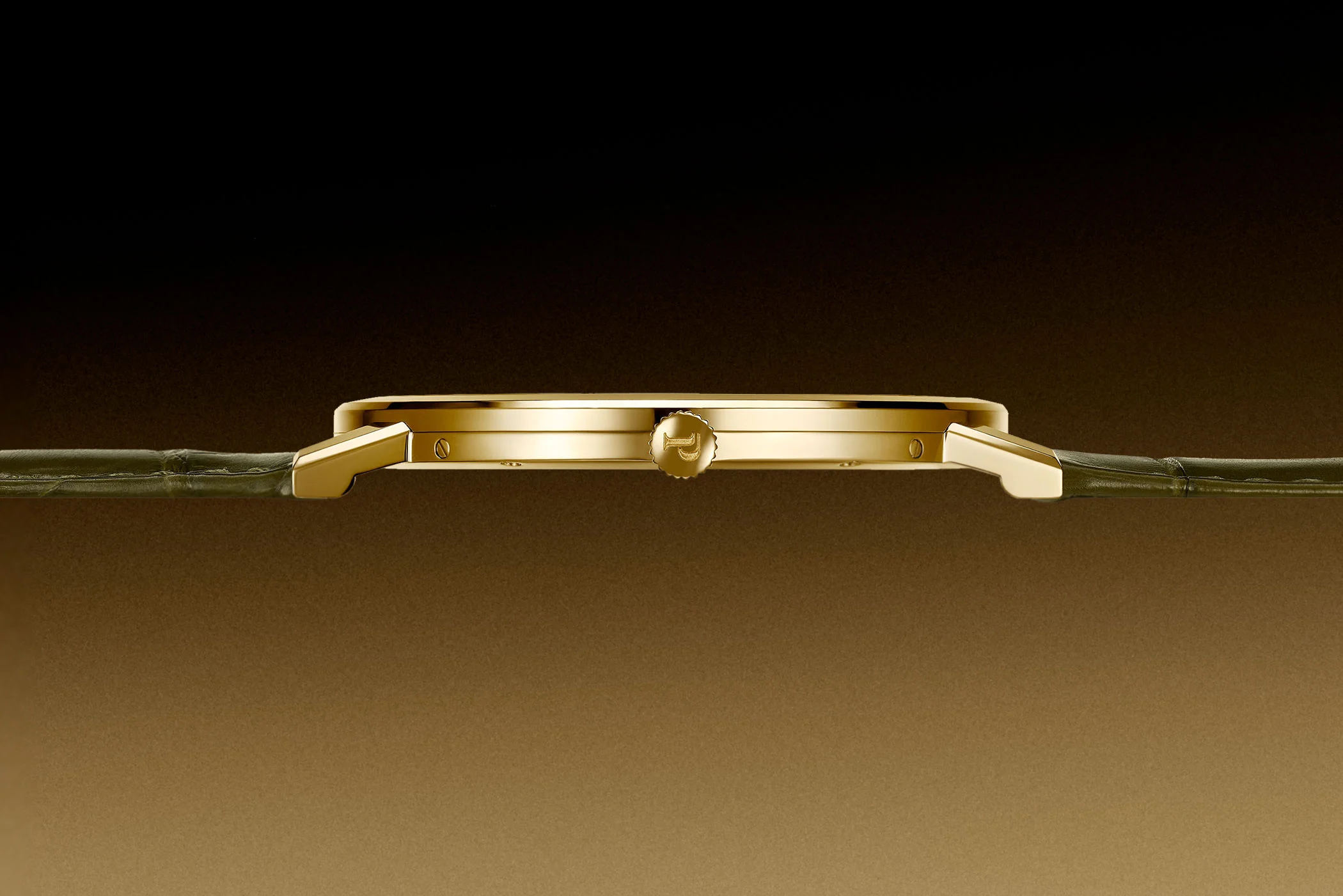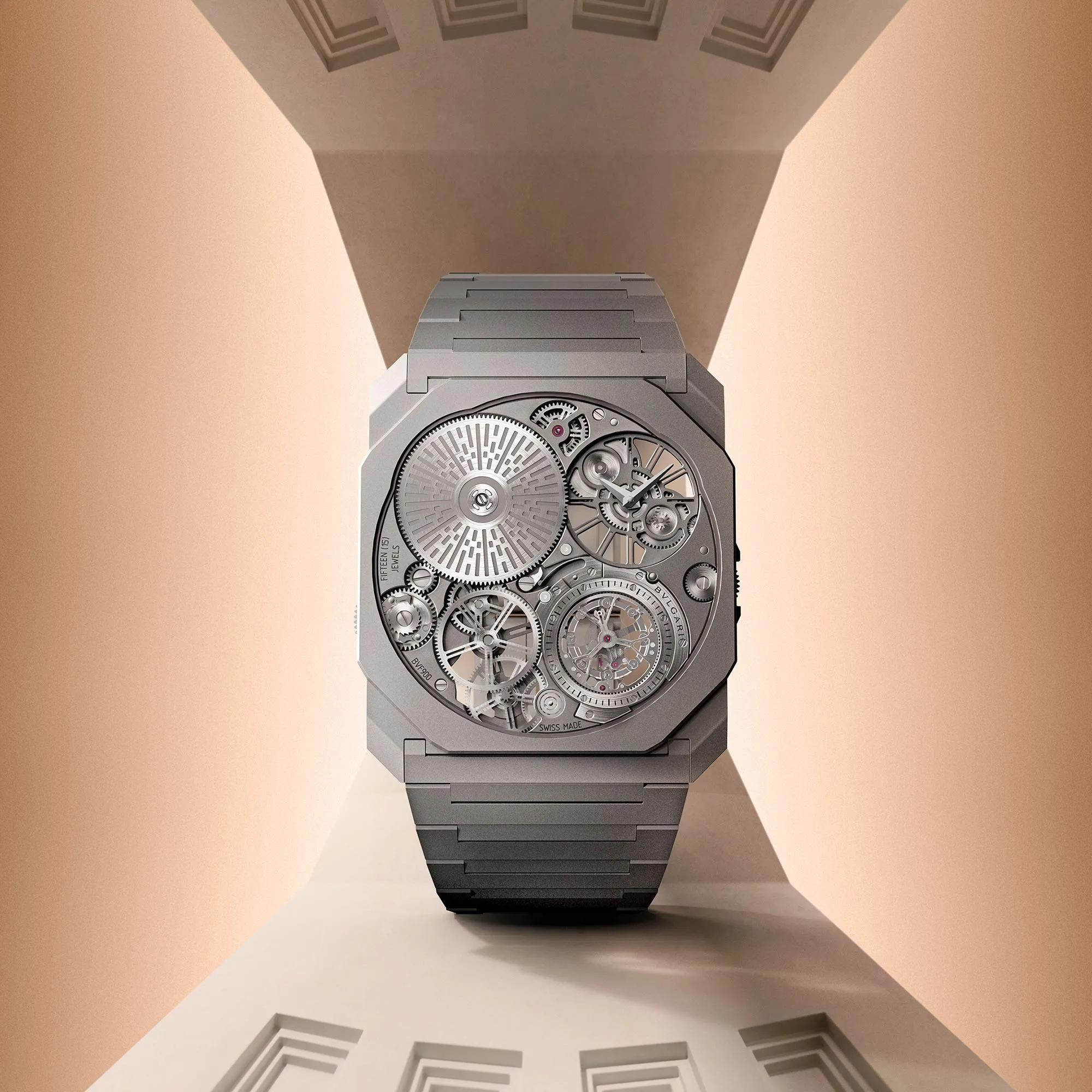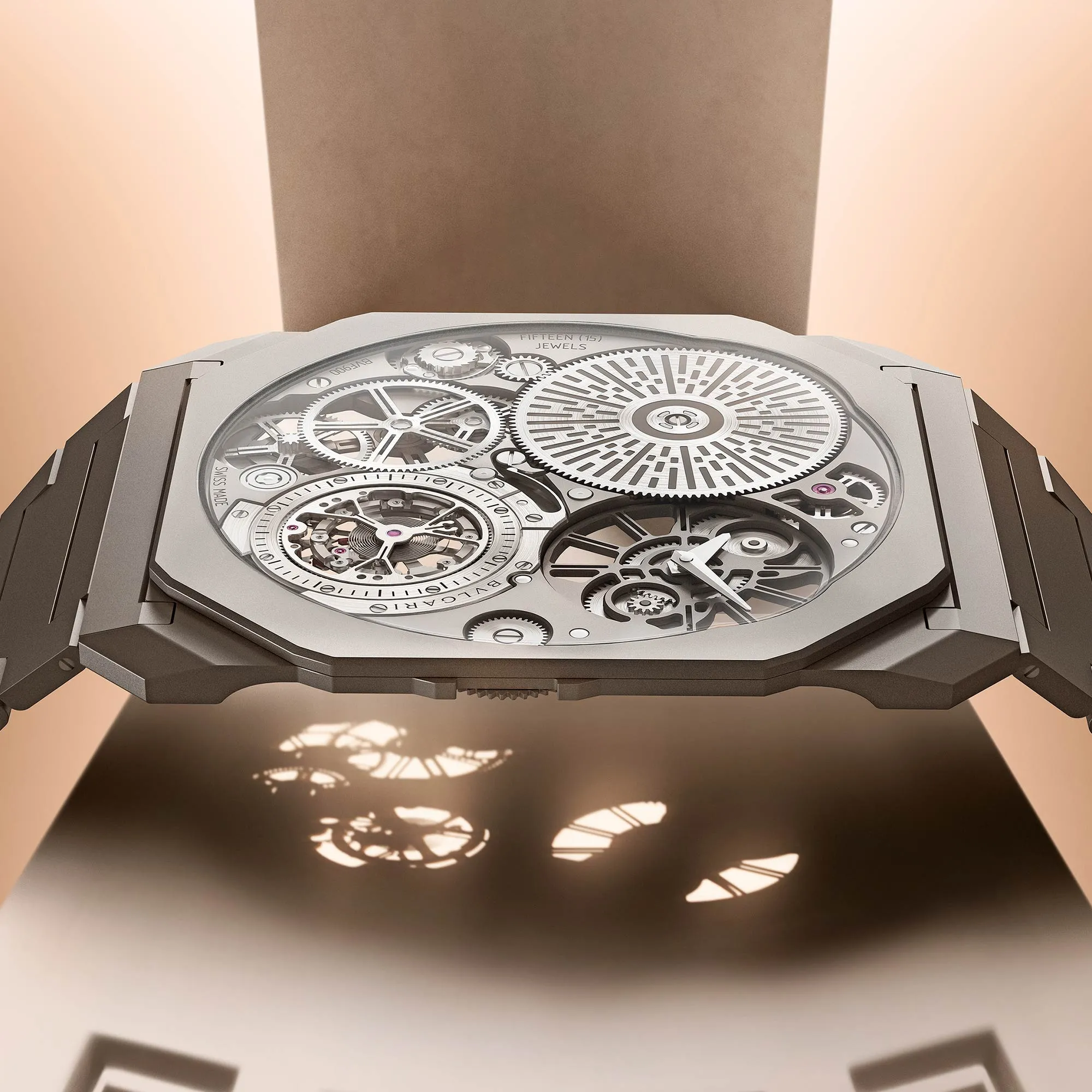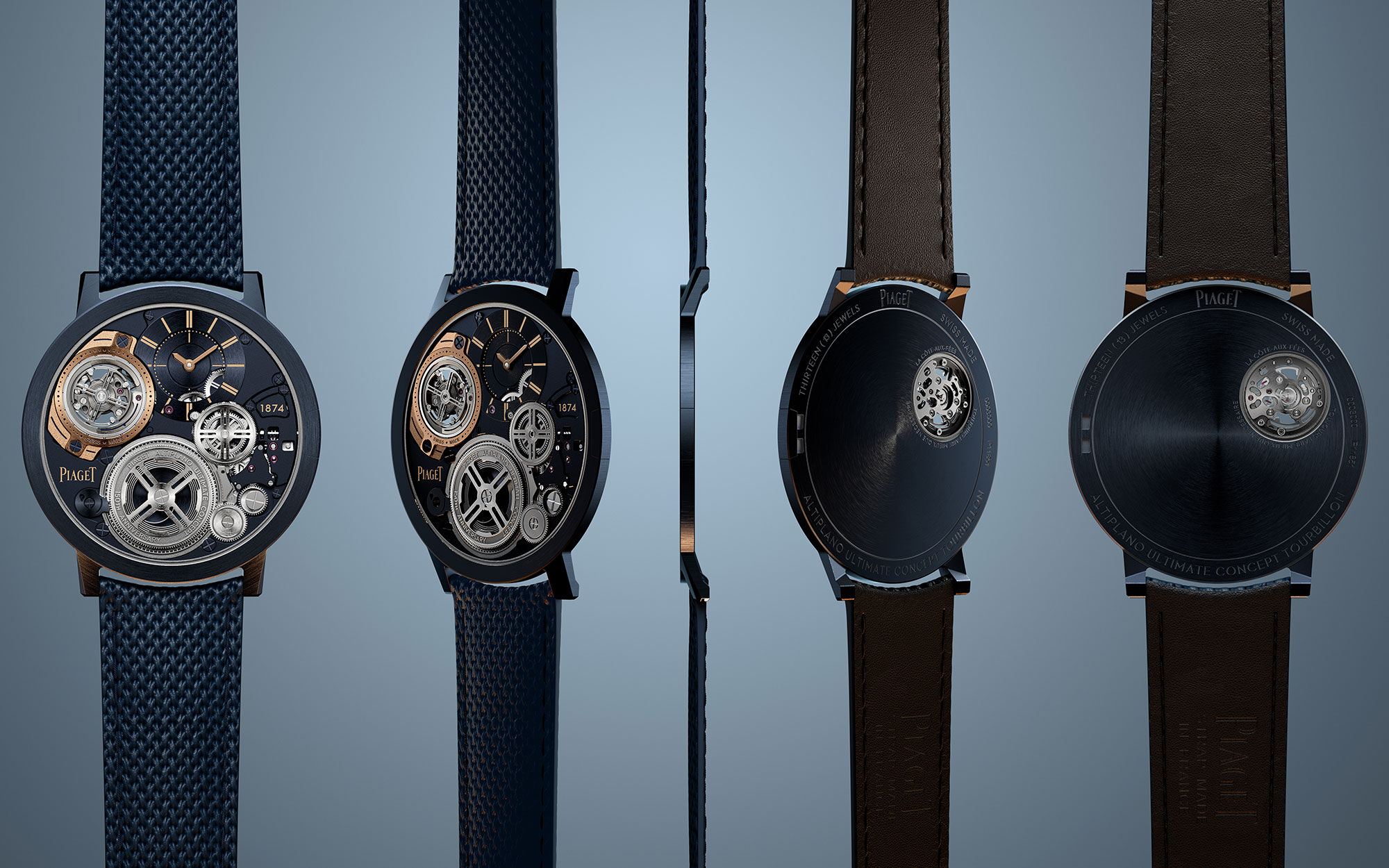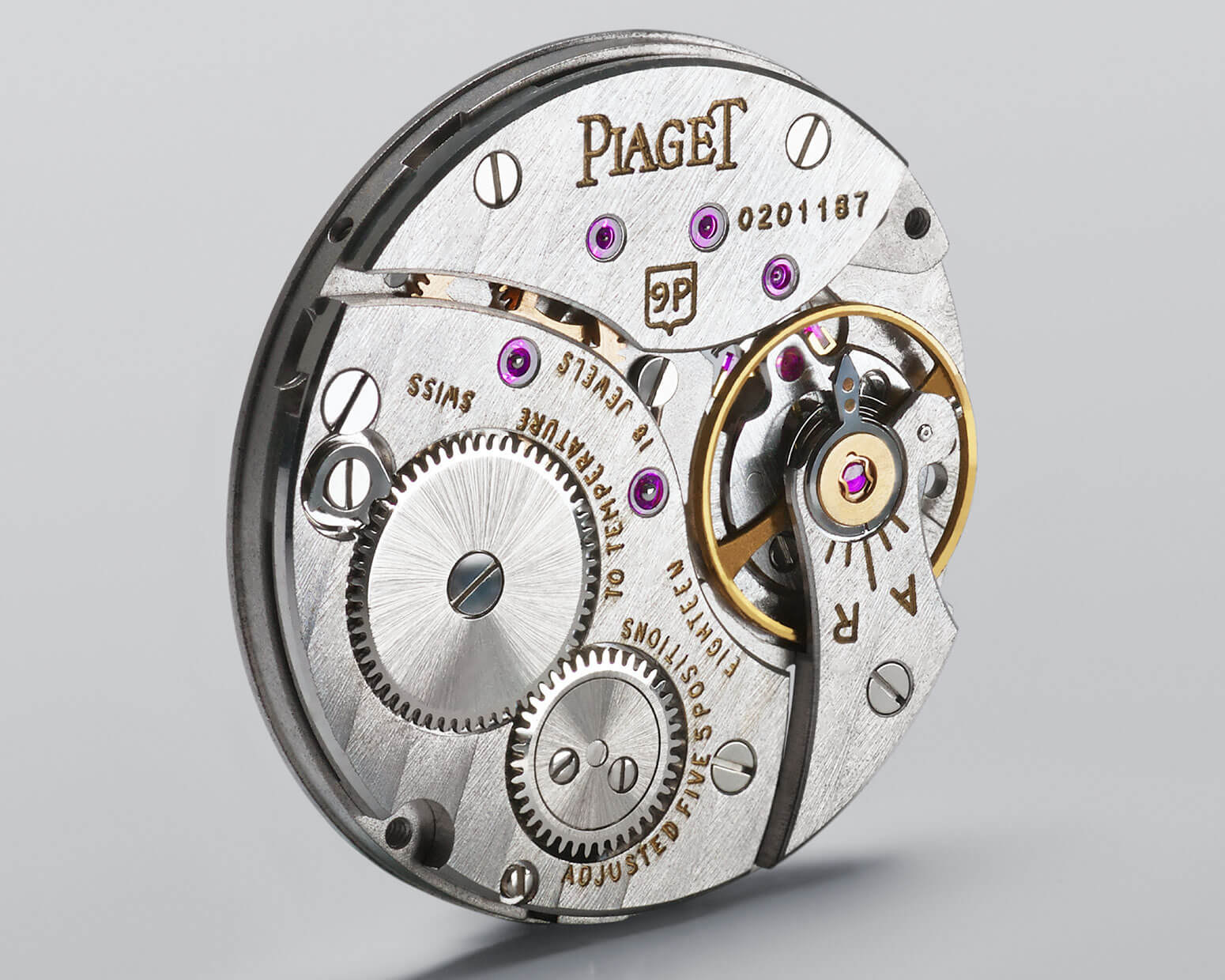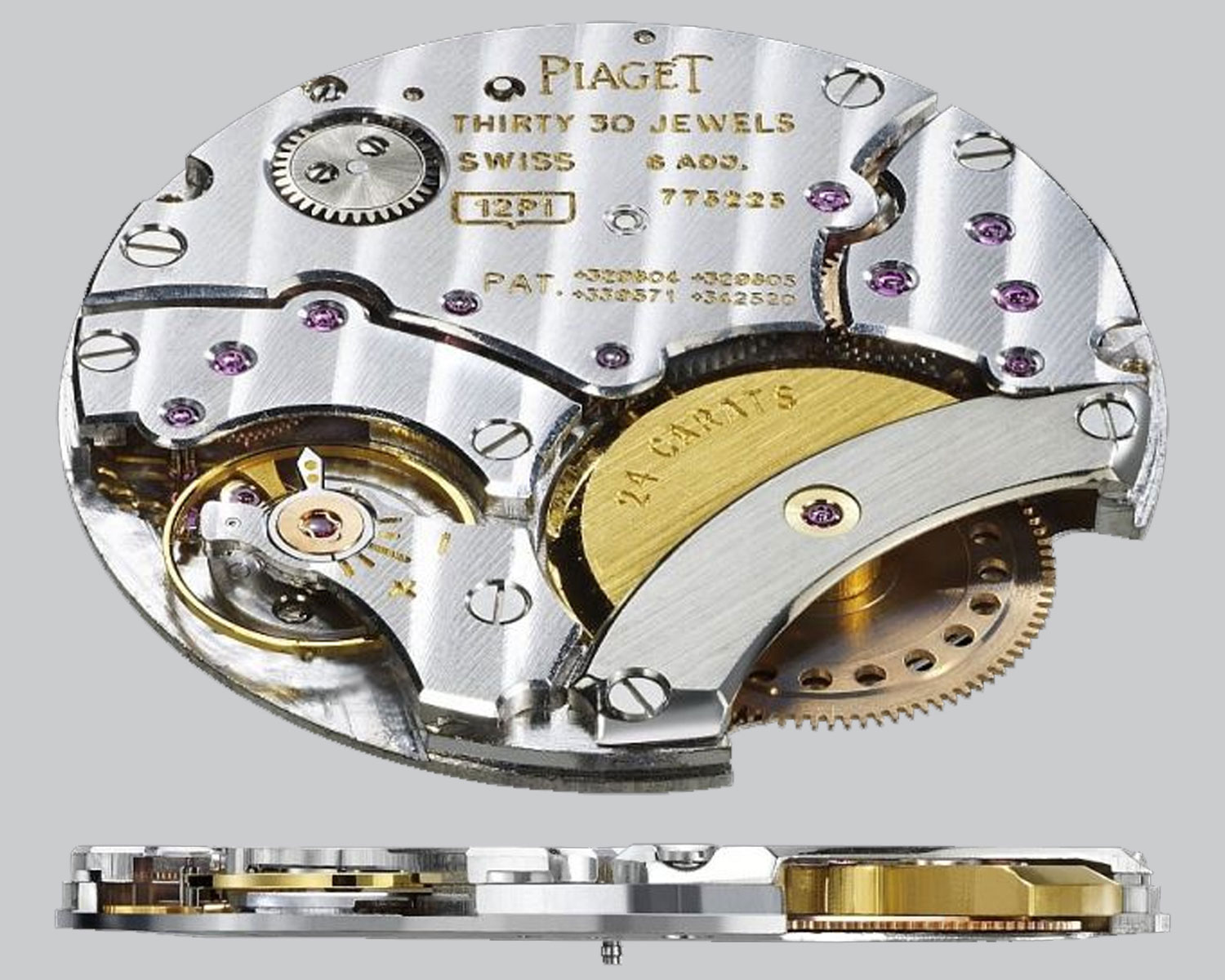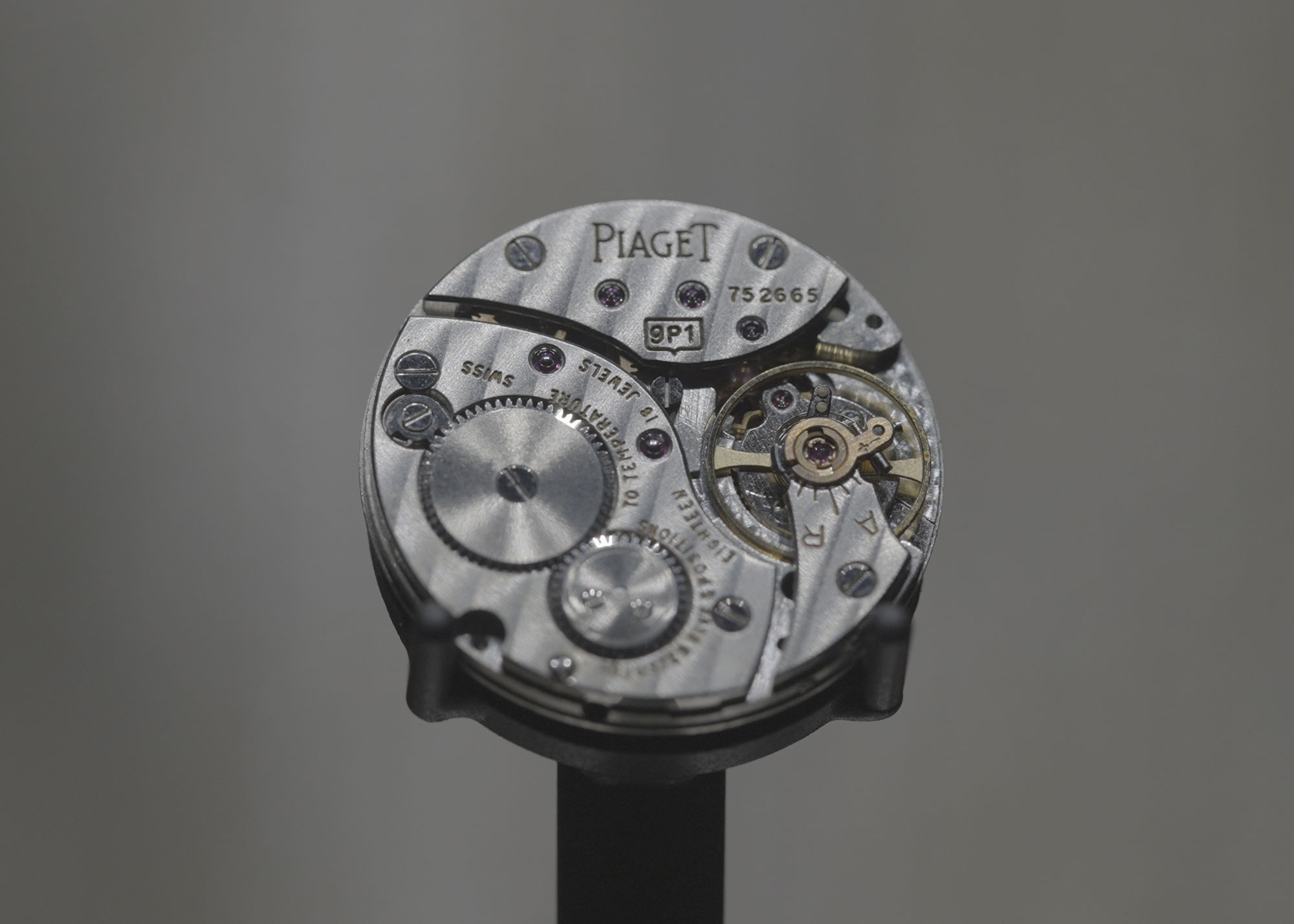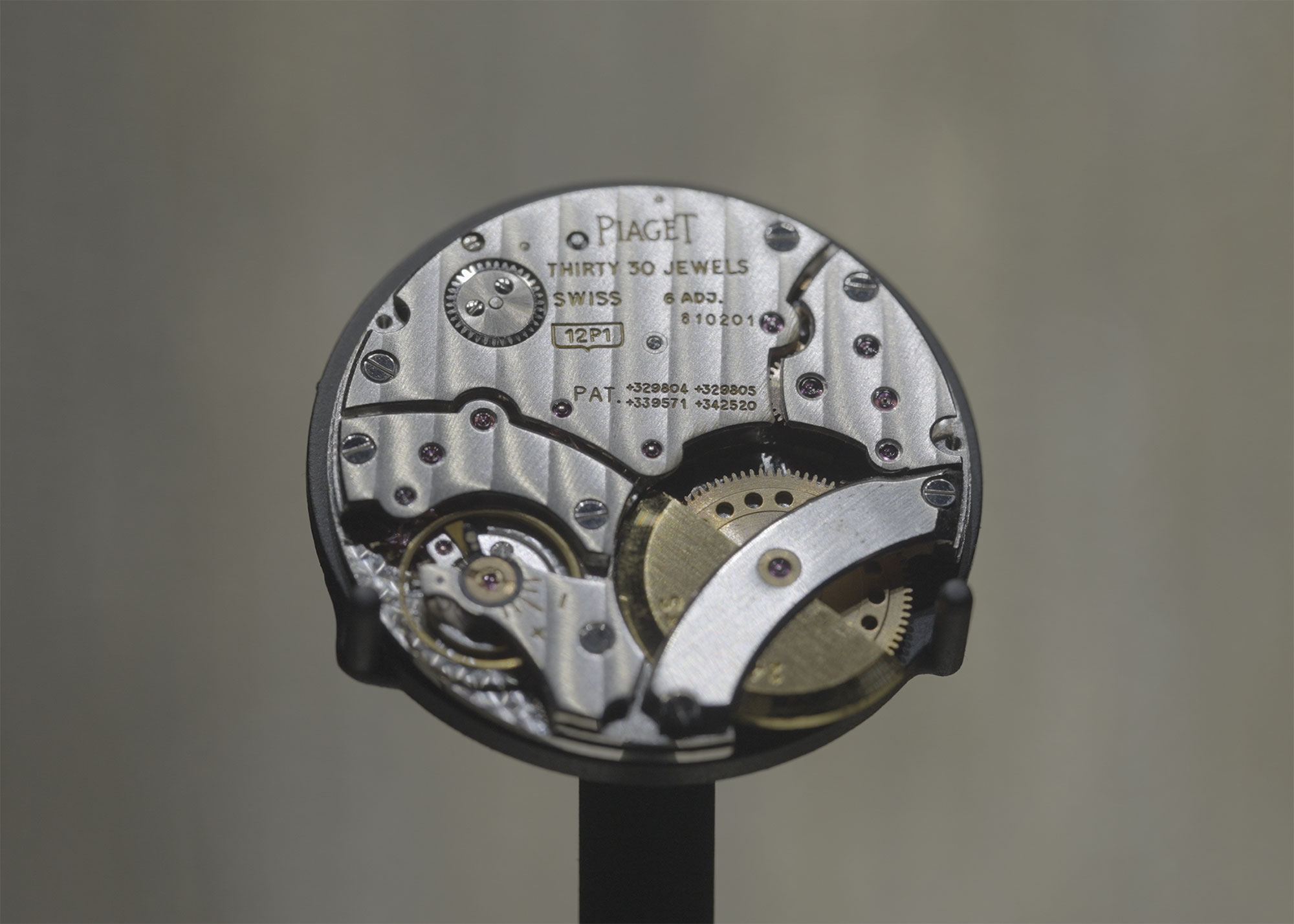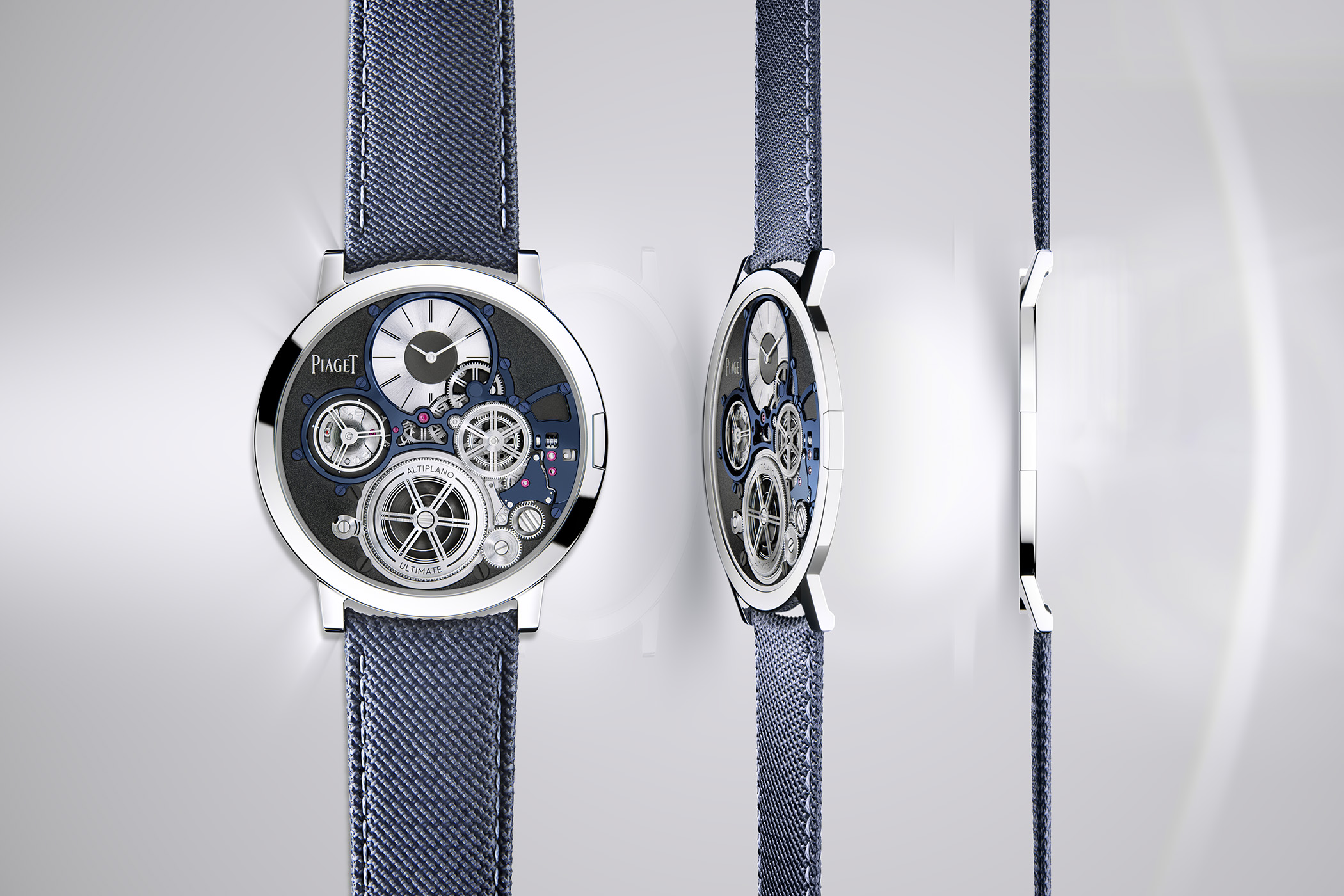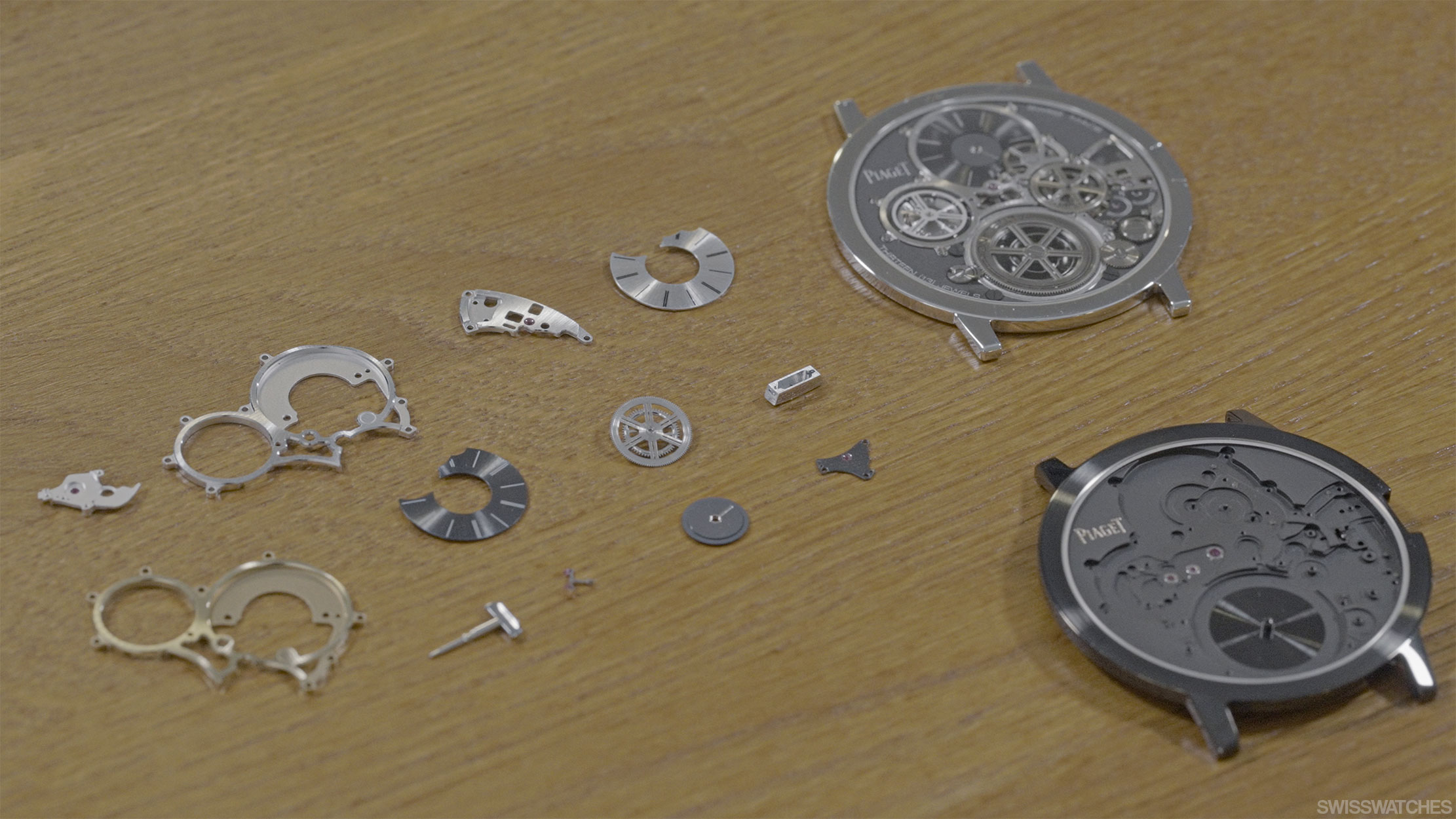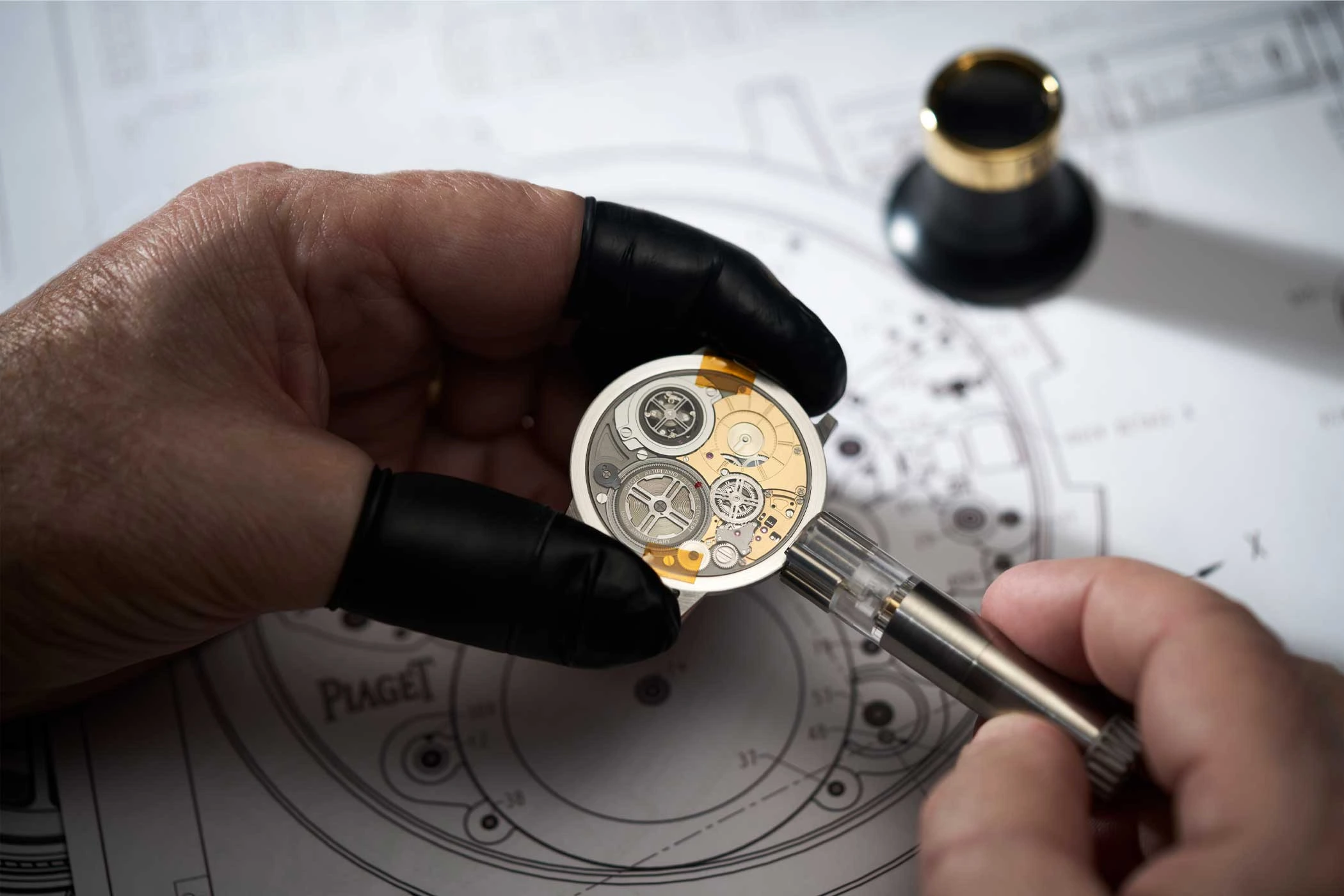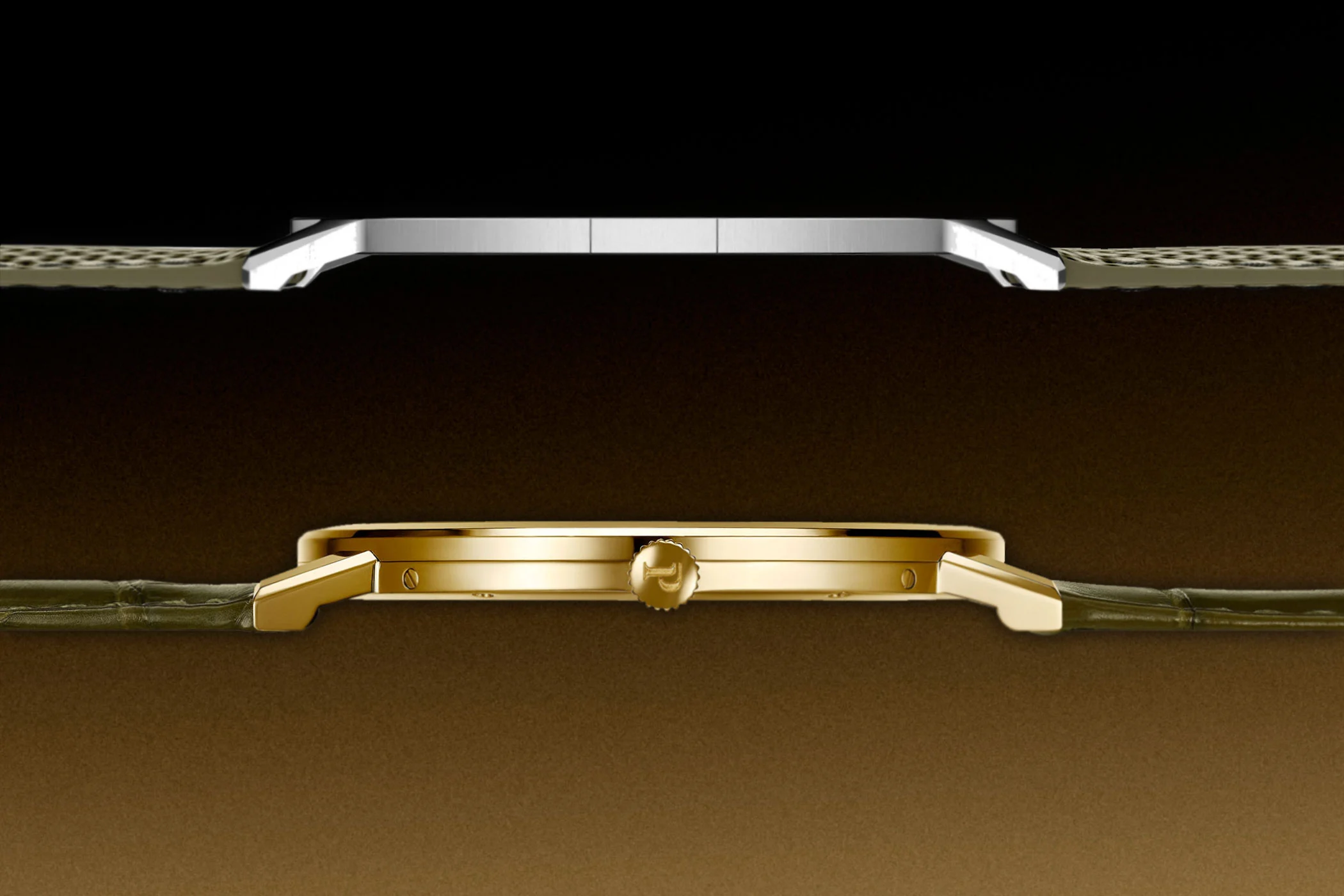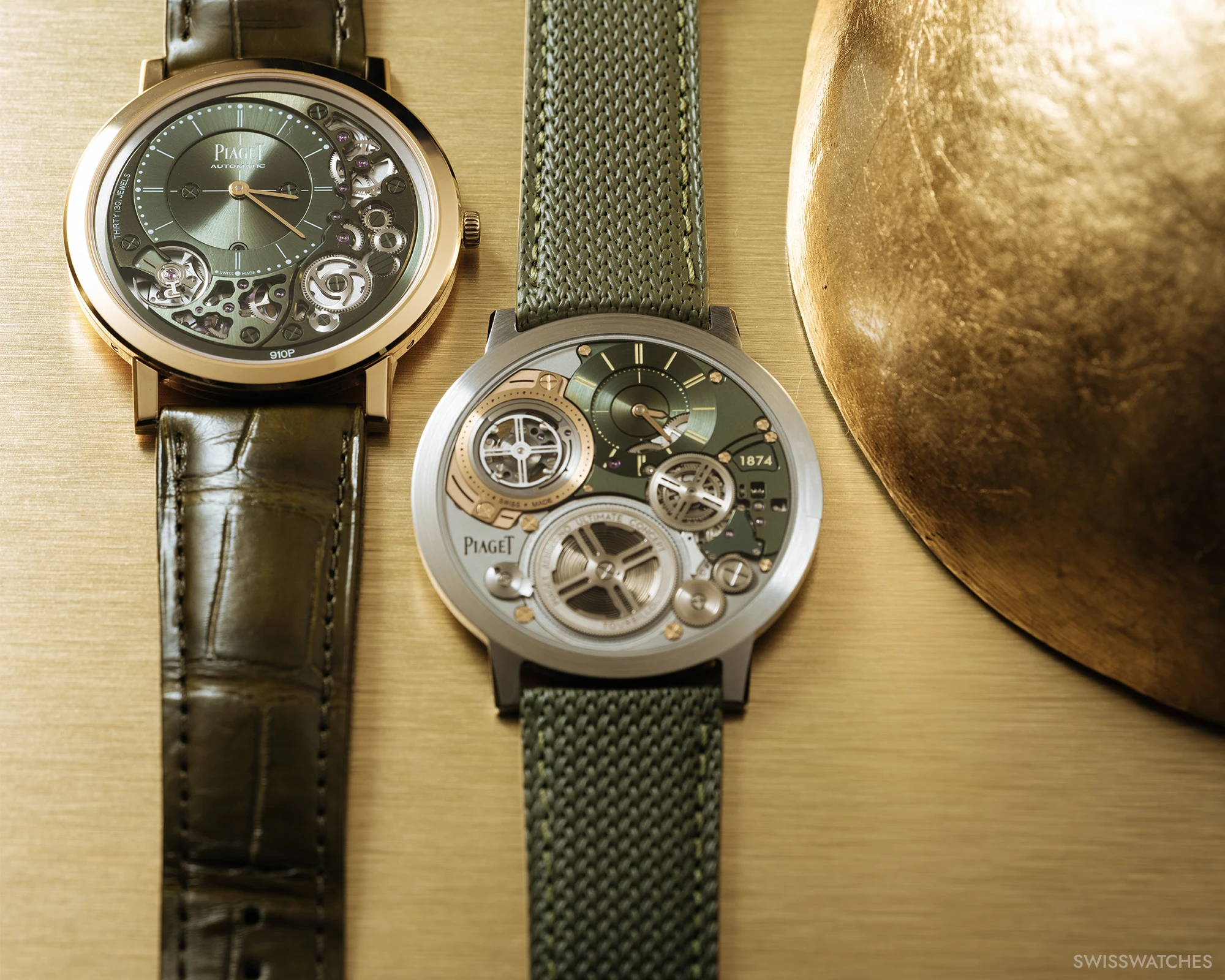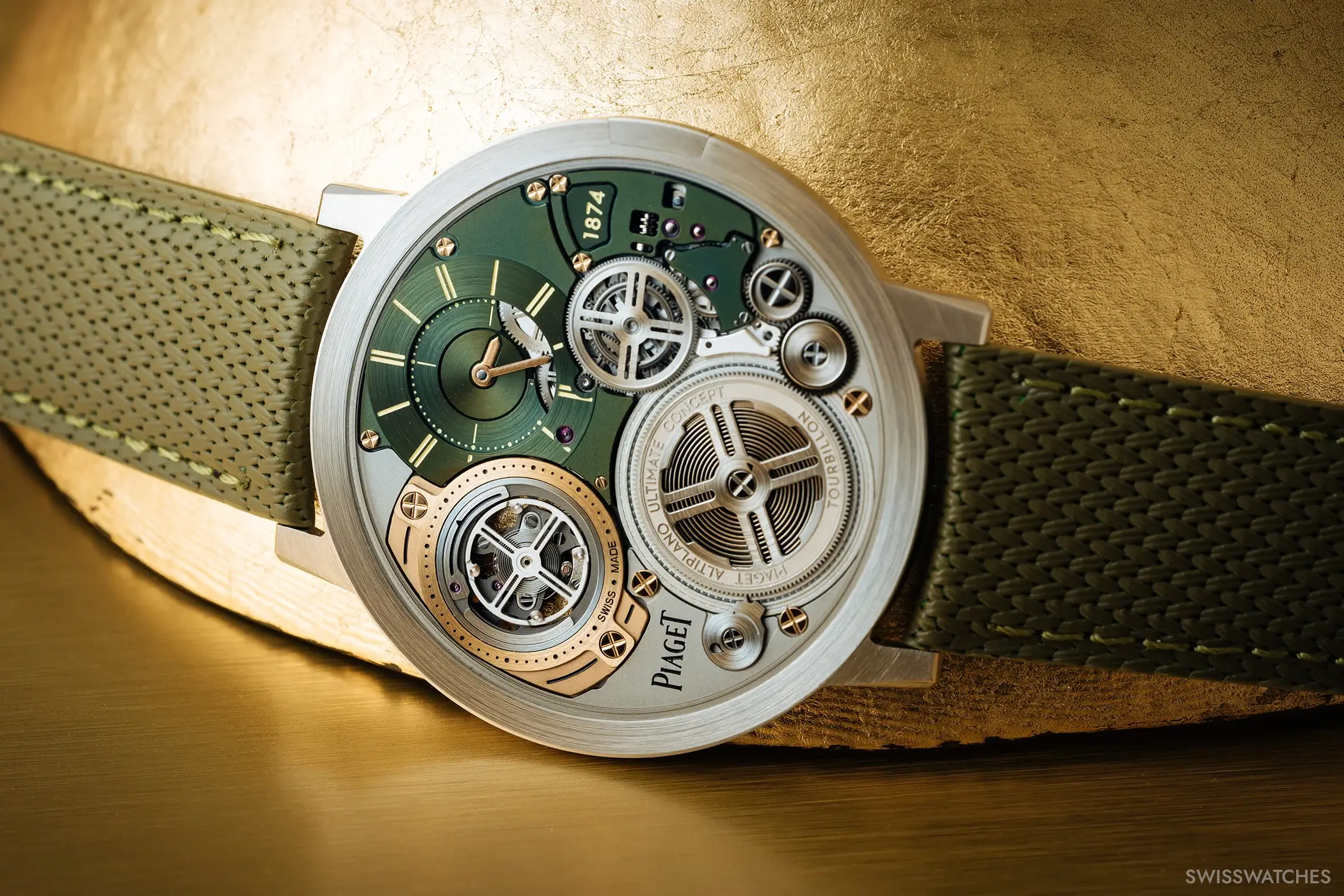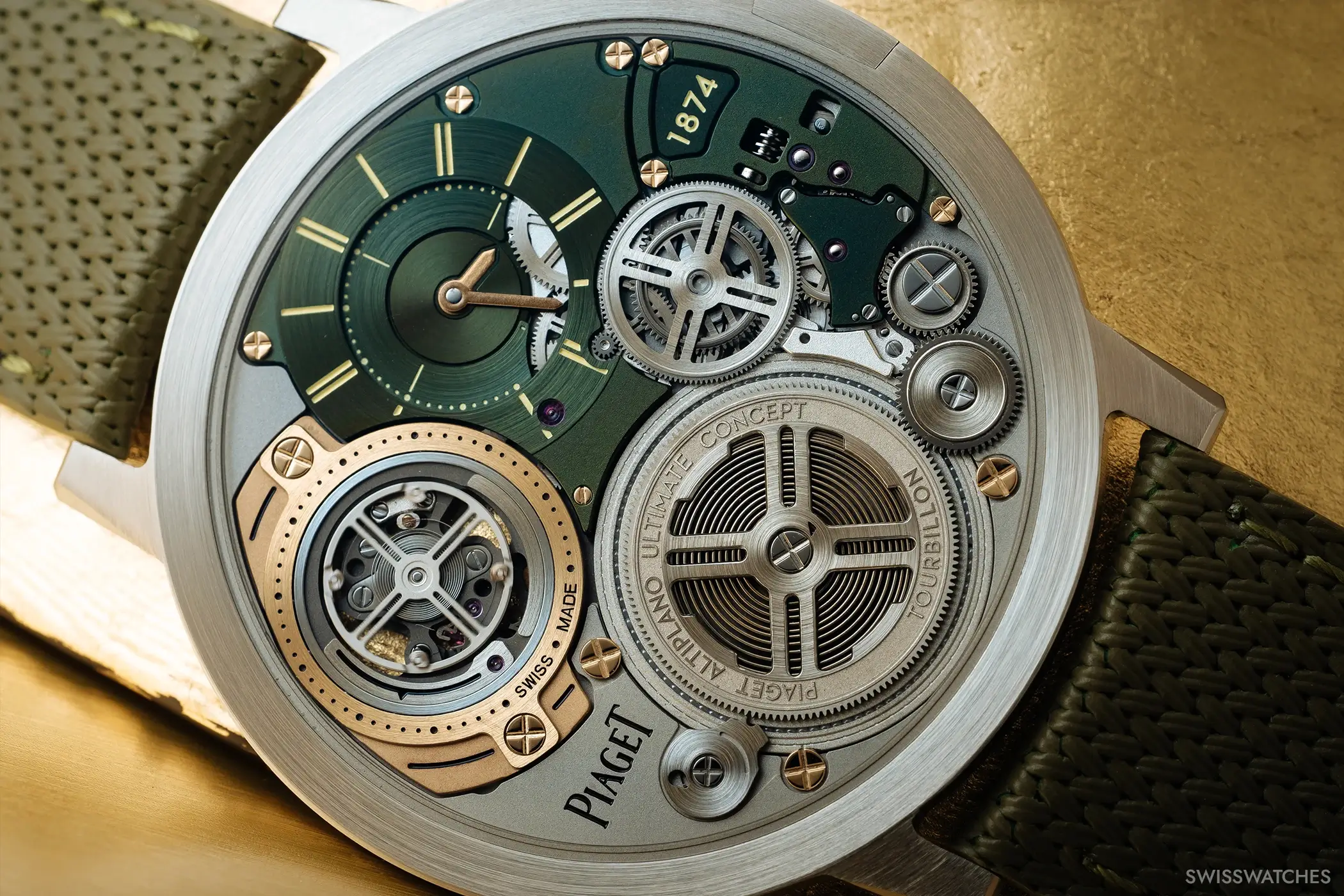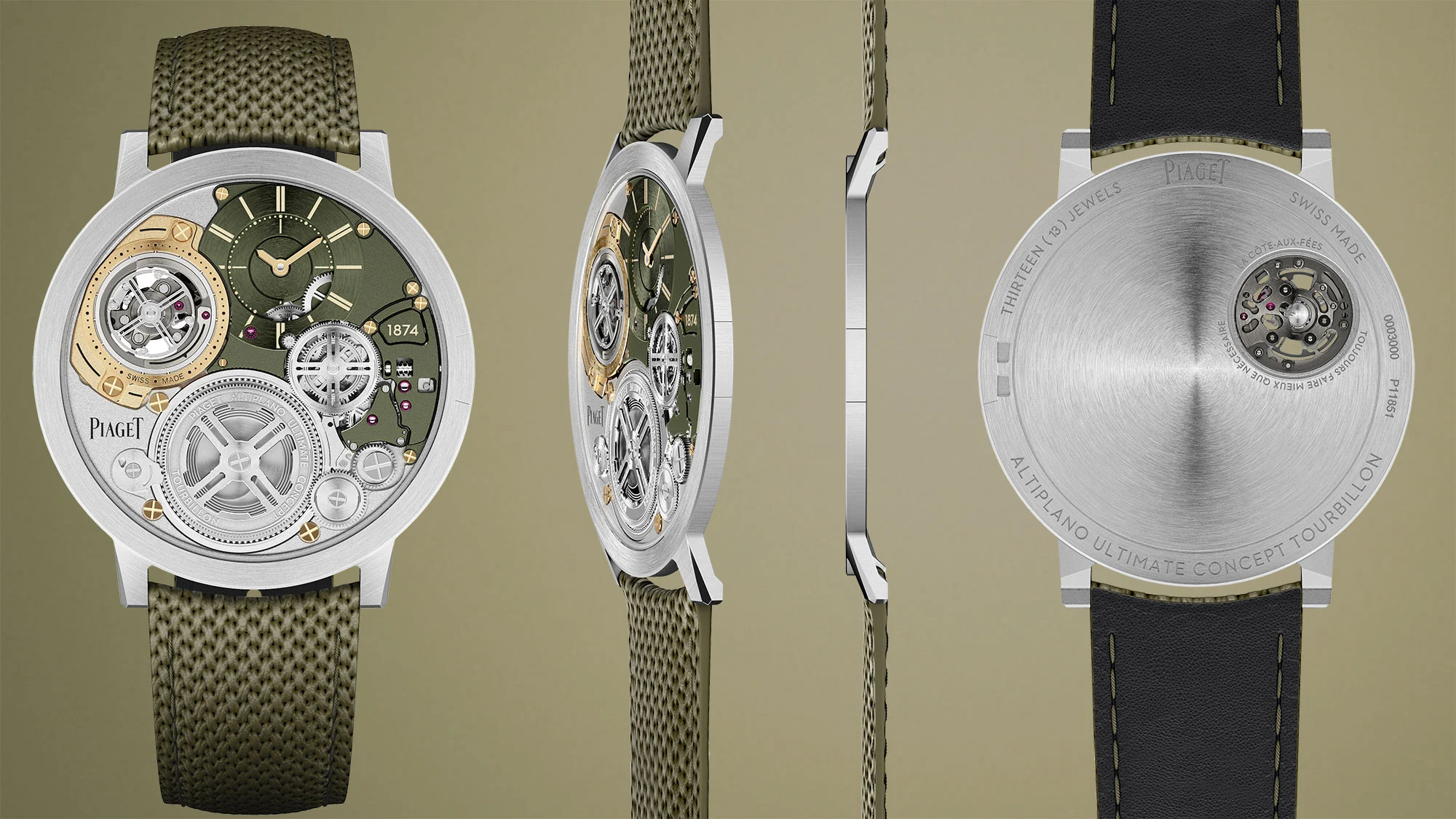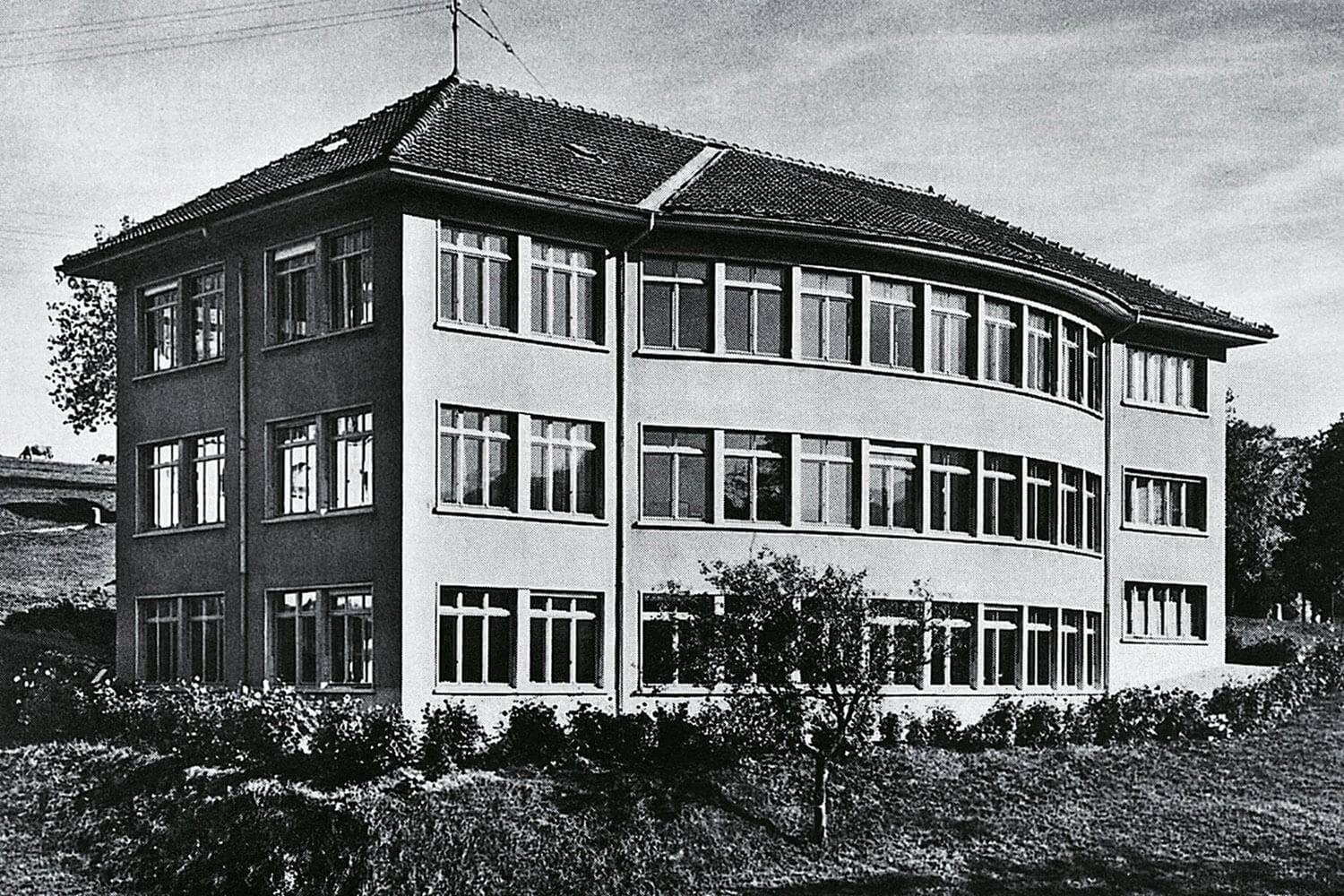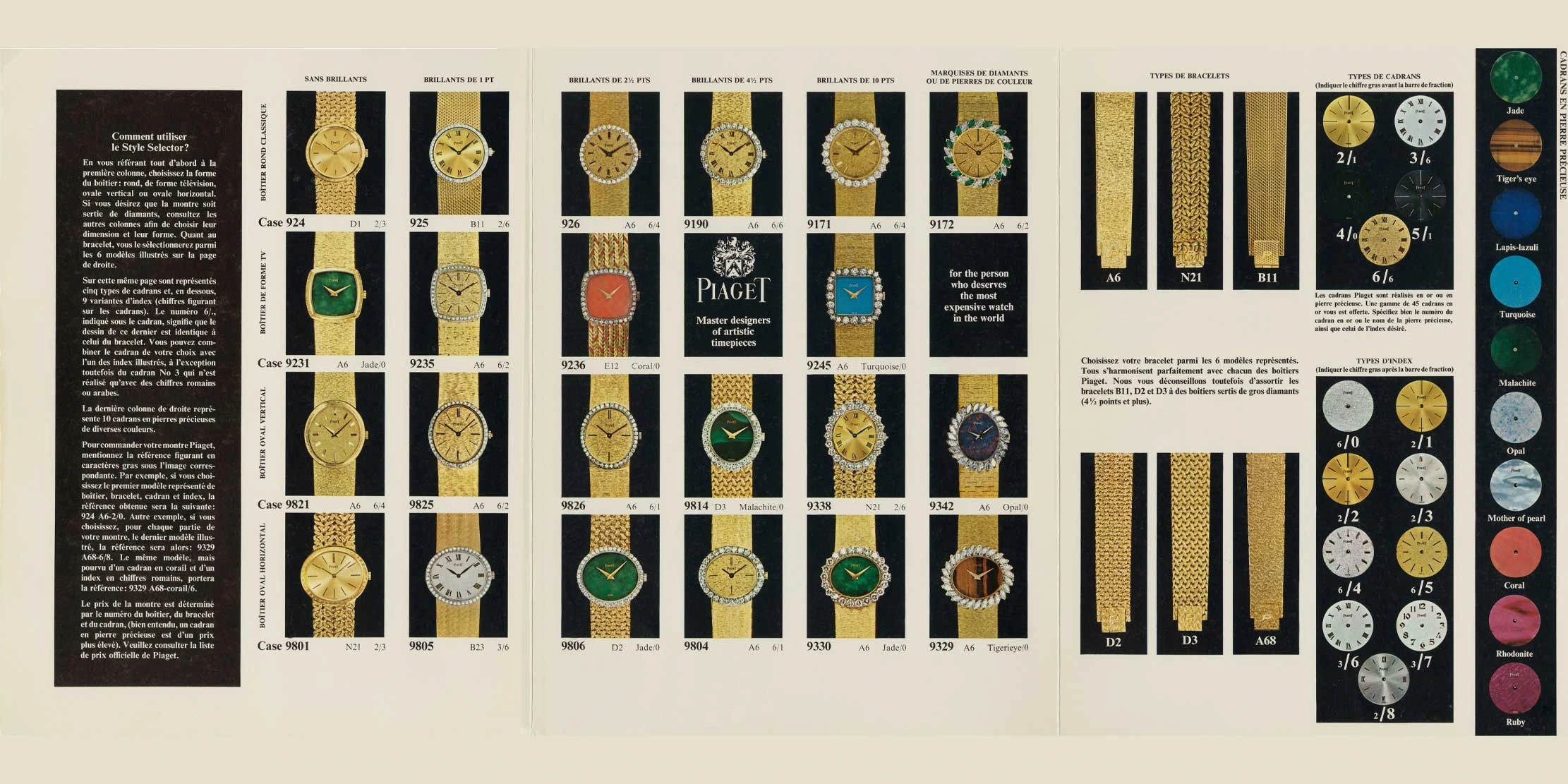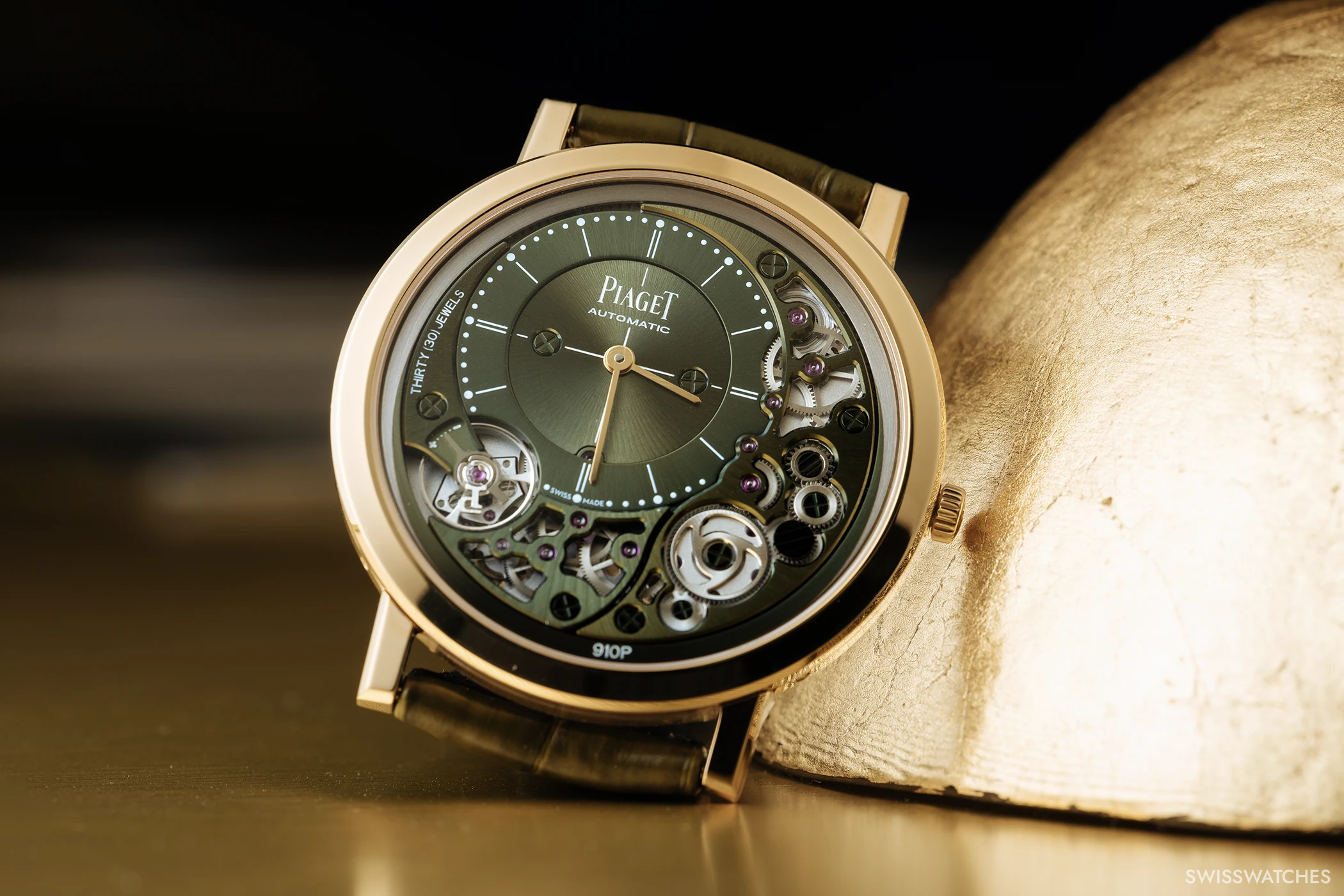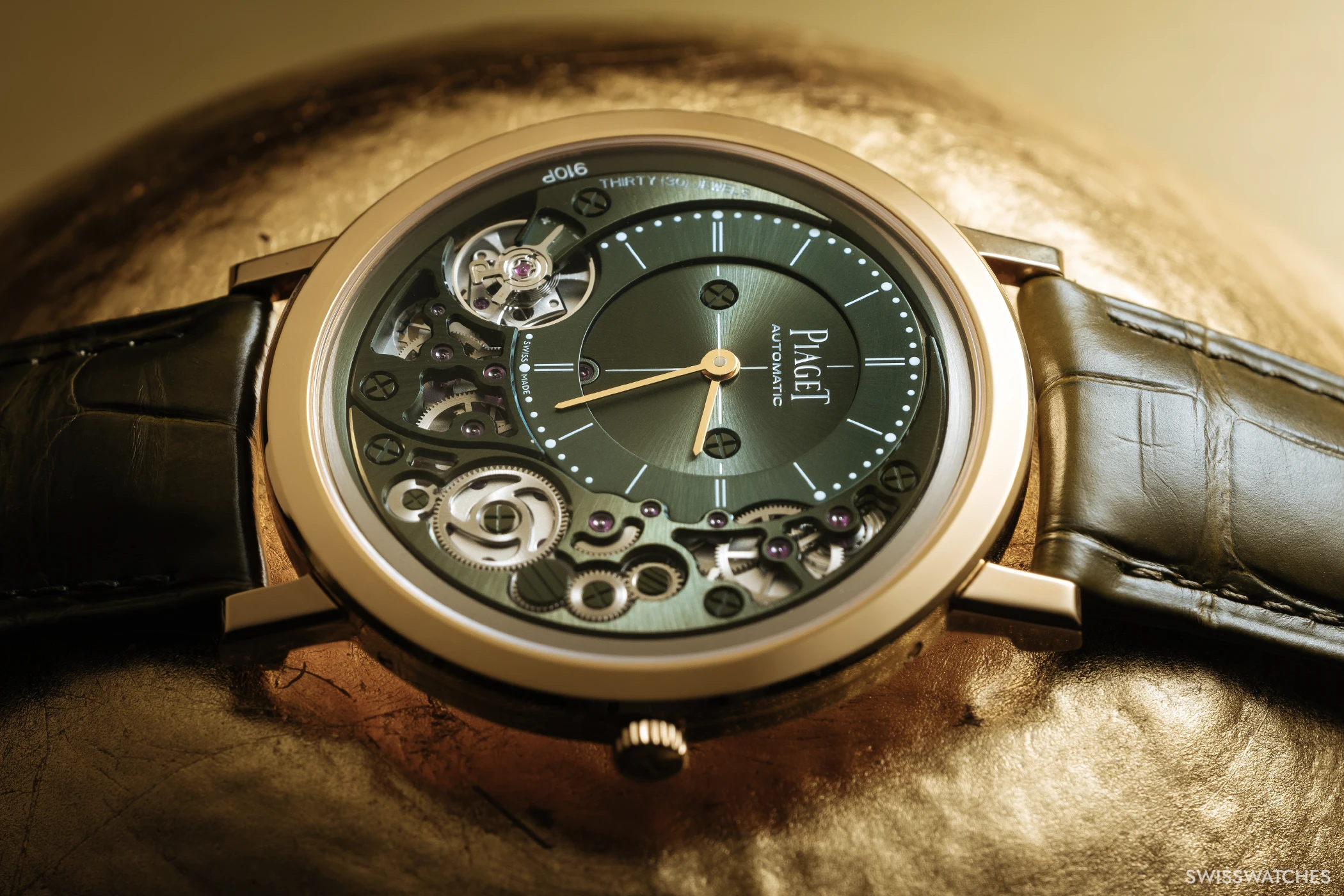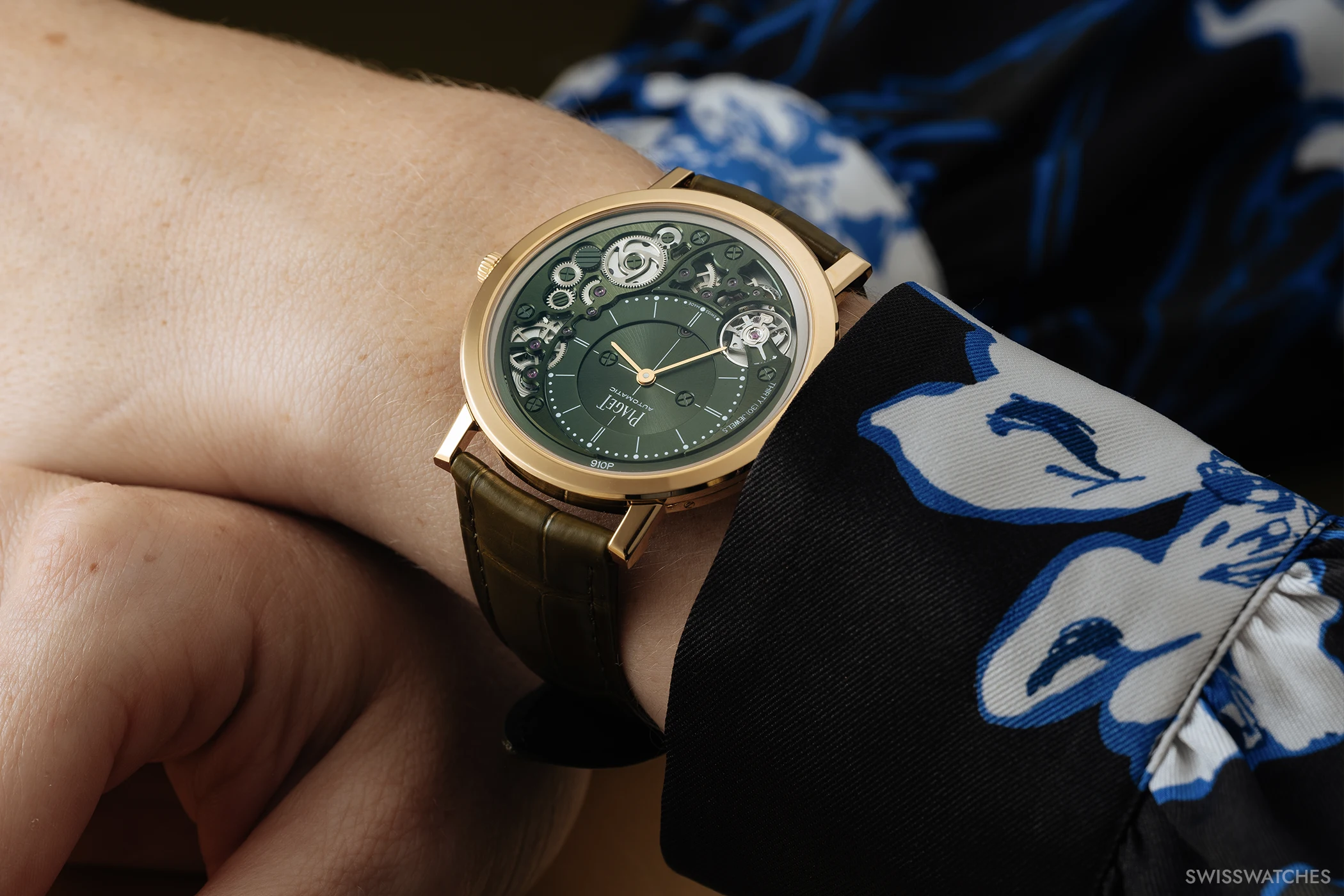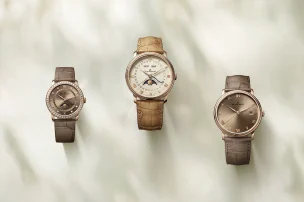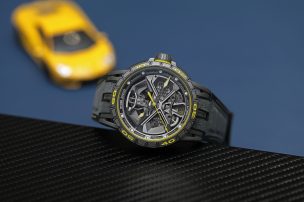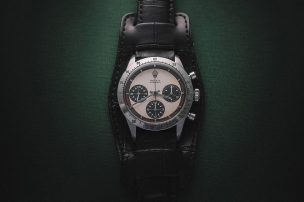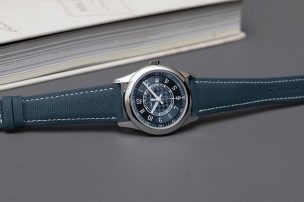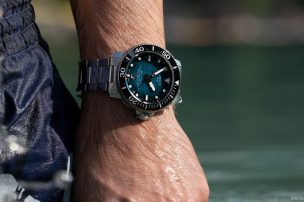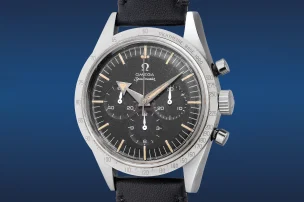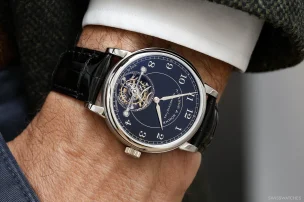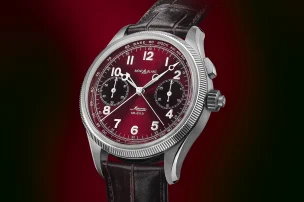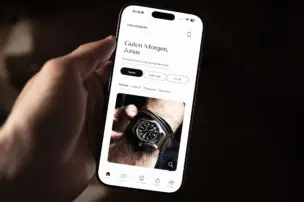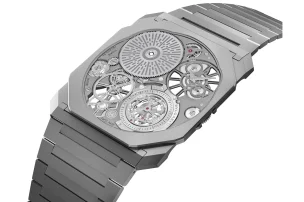

Piaget Altiplano Ultimate Concept Tourbillon and Altiplano 910P – A Masterfully Slim Concept for a Special Duo
Piaget presents two new concept watches. For the ultra-thin duo, consisting of the Altiplano Ultimate Concept Tourbillon and the Altiplano 910P, a special khaki green and gold colour combination was developed. Spoiler alert: there is no new world record to announce.
Does this sound familiar? You have an upcoming event where formal attire is the preferred choice, the outfit is carefully selected, and then it happens: the neatly tailored blouse or shirt cuff refuses to cooperate with your favourite, rather substantial watch. It snags, puckers, and pinches – constant readjustment is unavoidable.
It is at moments like this that one understands why some watch brands’ relentless pursuit of thinner, thinner, thinnest is hardly mere vanity. Admittedly, it wouldn’t be a disaster if it were. But an ultra-slim timepiece, almost two-dimensional in appearance, possesses its own charm even without a crisp blouse or smart shirt, creating a clean, elegant silhouette on the wrist.
It is no coincidence that a defining attribute of a dress watch is its slender profile. Nowadays, this is also possible with integrated complications – though these naturally add a layer of difficulty to the ‘ultra-thin’ endeavour. Nevertheless, the height continues to decrease, albeit now only in fractions of a millimetre. This makes the competition all the more fascinating.
Slim, Slimmer, Slimmest: World Records Thrill the Watch World
Since 2014, Piaget has enjoyed a friendly rivalry with Bulgari – the current world record holder in the category of thinnest wristwatch with a flying tourbillon – over the thinnest watch. But that’s a story in itself, which you can read more about in Jens Koch’s Swisswatches Magazine article.
Incidentally, last year this title went to Piaget’s Altiplano Ultimate Concept Tourbillon, launched at Watches & Wonders 2024. At two millimetres high, it is just 0.15 millimetres ‘thicker’ than Bulgari’s current record-breaking Octo Finissimo Ultra Tourbillon.
I am certain: the race is far from over, and the next pursuit of the coveted world record is already underway.
Piaget and the Fascinating History of Ultra-Thin Watches and Movements
The fundamental prerequisite for a slim watch is a slim movement. Piaget is among the masters of miniaturisation, reducing the already tiny components of any mechanical calibre to extraordinary dimensions. In doing so, the brand has liberated the adjective ‘thin’ from its negative connotations. And, it has been doing so since 1957, when the hand-wound 9P movement was introduced.
Piaget’s Journey as a Master of Ultra-Thin Wristwatches Begins with Calibre 9P
The number 9 refers to the size of the calibre: nine lignes, a historic unit of measurement in watchmaking, equivalent to just over 20 millimetres. The P naturally stands for Piaget. At just two millimetres in height, this hand-wound movement was the thinnest mechanical calibre in the world at its launch in 1957 and was fitted exclusively in precious metal watches.
Its successor, the calibre 12P, was launched in 1960. Although it was three millimetres thicker, it featured an integrated micro-rotor and thus automatic winding. Considering that CNC-assisted manufacturing was unheard of at the time and many steps were carried out by hand or with simple machines, Piaget’s ambitious pursuit of superlatives was already evident back then.
Then, as now, the manufacture follows the motto of its founder, Georges-Édouard Piaget: ‘Toujours faire mieux que nécessaire’ – in other words, ‘Always do better than necessary.’ Numerous records for thinness bear witness to this philosophy, whether in skeleton watches, watches with date displays, automatic or hand-wound chronographs.
Although the 9P calibre of 1957 is considered the starting point of Piaget’s enduring and undisputed expertise in ultra-thin watches and movements, the company’s mastery had already been evident long before.
Founded in 1874, the company was known as a manufacturer of delicate anchor escapements and miniature artworks. In the 1920s, this specialisation developed into another mainstay: the design, manufacture, and refinement of pocket watch movements, which set new standards at the time with a height of only 2.4 millimetres. Finally, in 1943, the company began marketing watches under its own name.
Piaget Gives Ultra-Thinness a Name: Altiplano Ultimate Concept – AUC
A good six decades after the birth of the 9P calibre, the Altiplano Ultimate Concept project was launched as Piaget’s ultimate idea of flatness, following the introduction of the Altiplano collection in 1998.
After four years of research and development, the Manufacture presented the first AUC timepiece at the Salon International de la Haute Horlogerie (SIHH) in Geneva in 2018. With a total height of just two millimetres, this watch was the subject of five patent applications.
The two-hand model housed the newly developed hand-wound calibre 900P-UC. Two years later, it was awarded the prestigious Aiguille d’Or at the Grand Prix d’Horlogerie de Genève (GPHG).
Since then, many further AUC versions have appeared. The integration of complications, which would normally increase the height of the movement, has not prevented the continued reduction in case thickness. Piaget achieves this by allowing case, movement, and dial to increasingly merge into a single entity.
The preliminary highlight – or rather ‘low point’ – was the Altiplano Ultimate Concept Tourbillon, launched last year to mark Piaget’s 150th anniversary. With a diameter of 41.5 millimetres and a cobalt alloy case with blue PVD coating, the two-millimetre-thick timepiece with flying tourbillon looks almost like a drawing on cardboard at first glance. When worn on the wrist, you immediately feel the high level of comfort offered by such an ultra-thin and lightweight watch.
Altiplano Ultimate Concept Tourbillon and Altiplano 910P – An Ultra-Thin Duo in Khaki Green and Gold
The new Altiplano duo features yellow gold combined with khaki green, while the ultra-thin AUC version with tourbillon also features a cobalt alloy for the two-millimetre-high case, which is water-resistant to two bar.
Unlike the automatic Altiplano 910P model, the new AUC also allows future owners to get creative themselves thanks to the configurator.
Altiplano Ultimate Concept Tourbillon – When Case, Movement and Dial Become One
With a diameter of 41.5 millimetres and a height of just two millimetres, this new ultra-thin tourbillon model is a reinterpretation of last year’s anniversary edition. It leaves little room for internal mechanics: the compact space is fully occupied by the hand-wound calibre 970P-UC, which oscillates at 4 Hz (28,800 A/h) and offers a power reserve of 35 hours.
It is based on the 900P-UC, but also features a peripherally arranged, flying 1-minute tourbillon. That sounds easier than it was. Around 90 percent of all existing parts had to be redesigned due to the limited space available. ‘Everything was redesigned,’ explained Benjamin Comar, CEO of Piaget, at last year’s Watches & Wonders.
With the new Altiplano Ultimate Concept Tourbillon (reference G0A50530), the manufacturer has once again opted to treat the case, movement, and dial not as separate units, but as an integrated module. Accordingly, the various components are arranged side by side rather than on top of each other.
In addition, the caseback serves as the mainplate for the movement, and all bridges, gears, and bearings are integrated directly into the case. The rotor is also ring-shaped and sits on the outer edge of the movement rather than above the other components. This is what makes the ultra-flat architecture possible in the first place.
There are two engravings on the back of the watch: the Piaget motto ‘Toujours faire mieux que nécessaire’ (Always do better than necessary) and the words ‘La Côte-aux-Fées’. This is the village where Piaget was founded and where the brand’s most exceptional pieces are still made today.
The AUC Tourbillon is secured to the wrist with a khaki green calfskin strap featuring a newly developed pattern called Polish Mesh and a pin buckle. The price is 730,000 euros.
Entirely personal – the AUC is part of the ‘Infinitely Personal’ programme
This personalisation concept is based on the Style Selector, which Piaget offered its customers in the 1960s. This allowed customers to choose the shape of the case, the type of dial and strap, and the extent of the gemstone setting themselves.
It was, so to speak, the analogue precursor to today’s digital Piaget Infinitely Personal configurator. Introduced in 2020, this configurator offers, among other things, the option of selecting individual finishes, materials, and engravings for the Altiplano Ultimate Concept Tourbillon.
Altiplano 910P – Consistent Colour Scheme
This model is the first in the Altiplano collection to feature a yellow gold case. It is consistently combined with khaki green. The name already makes it clear that the Altiplano 910P (reference G0A50126) does not belong to Piaget’s illustrious circle of concept watches. With a height of 4.3 millimetres, it is still exceptionally slim. But not slim enough to receive the AUC certification.
Housed in a 41-millimetre case water-resistant to two bar, the automatic 910P movement has a 48-hour power reserve and a frequency of 3 hertz (21,600 vph). It features an off-centre hours and minutes display at 10 o’clock.
The Altiplano 910P is worn on a khaki green alligator leather strap with a buckle clasp. The price is 40,500 euros.
